
One Big Scam
Any discussion of ANY filter requires a disclaimer. ALL commercial filters almost without exception tell the owner to replace the filter media (Cartridges, sponge, ceramic rings, carbon, Matrix, etc.) on a regular basis, once a month, once every three month or once every six months. Supposedly this is because the media becomes clogged and dirty. And the media is ridiculously expensive. We must emphasis:
.
Replacing the Filter Media is a Big SCAM!!!
.
Yes, there is absolutely no reason to replace the media on a regular basis other than to make a lot of money for the supplier of the filter.

Review Of Aquarium Filters
Every aquarium needs a filter to do the biofiltration. These filters have many different aspects which need to be considered.
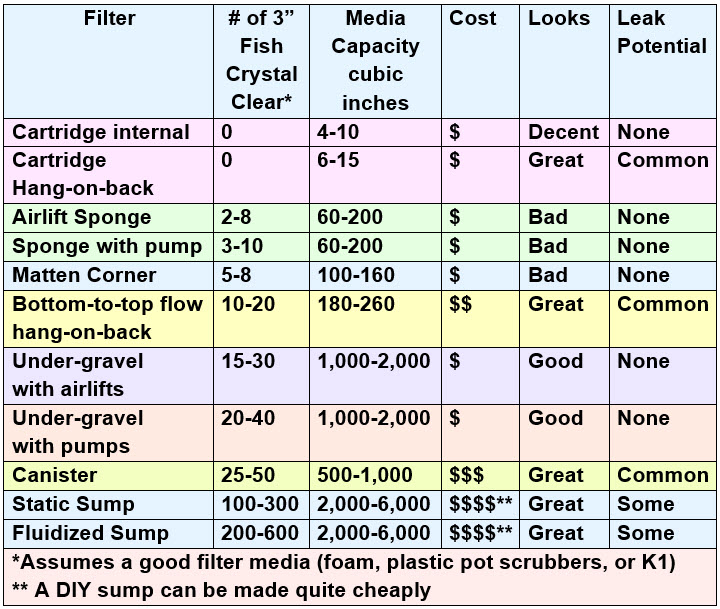
*# of 3″ Fish refers to the number of three inch fish that can be given crystal clear water with this filter. Ammonia oxidation is much easier than crystal clear water so for ammonia oxidation multiply the numbers by ten to twenty. Note this chart is a very very gross approximation. Also this review assumes a typical 29 to 40 gallon tank with correspondingly sized filters. And it assumes that an overflow siphon is not visually objectionable while a dirty sponge sitting in a tank is objectionable.
This is a very simplistic analysis which won’t satisfy the dedicated hobbyist.
To go into filters in a much deeper review go to the following link:
8.1. Review of Types of Filters in Depth
.

General Comments on Types of Filters
The larger the fish and the more fish the more cubic inches of media are needed. All these filters have their pluses and their minuses. Which one you use is a matter of personal preference and wallet size.
Personally I love under-gravel filters and have always had them on ALL my tanks. I find hang-on-backs to be very poor performers compared to under-gravels and I haven’t owned a hang-on-back in many years. And sponge filters are great for breeding tanks but kind of ugly in decorative tanks. Large tanks (>75 gallons) with lots of fish and/or large fish do best with sumps.
Many hundred million dollars of research in recirculating aquaculture systems (RAS) has clearly established that two or three chamber K1 Fluidized Bed Sumps are two to four times better on a cubic inch per cubic inch basis of filter media than any other filtration system.

Hang-on-back filters are sometimes the only option for folks, especially for small tanks. Cartridge hang-on back filters (or cartridge in-tank filters) are very poor for biofiltration. They will oxidize ammonia but they won’t give crystal clear water. They are especially bad if one replaces the cartridges once a month like the directions say (this is simply one big scam to make money!).
For hang-on-back filter optimization Corey’s (Aquarium Co-op) has an excellent video. It’s a great video from a guy who knows his stuff. He recommends replacing the media, cartridges and baskets with foam blocks and adding foam pre-filters to the inlet tube. This will decidedly improve any hang-on-back filter.
If a filter rapidly plugs up with brown gunk in a week or two weeks the filter is simply too small to do an adequate job of filtration. While low biofiltration (i.e. filter size) is the major factor other factors can contribute to it:
- Heavy stocking
- Heavy feeding
- Low protein food
- Low aeration

Test of Filters
A test of the ammonia oxidizing capability of various filters was tested with the media recommend for use with them, except that any mechanical filtration such as Polyfil or 40 ppi foam was not used. The various filters and their ammonia oxidizing capabilities tracked very closely to their filter media surface area. Cartridge filters and hang-on-back filters did not do well, canisters and under-gravel filters did moderately well, and the sumps did great.
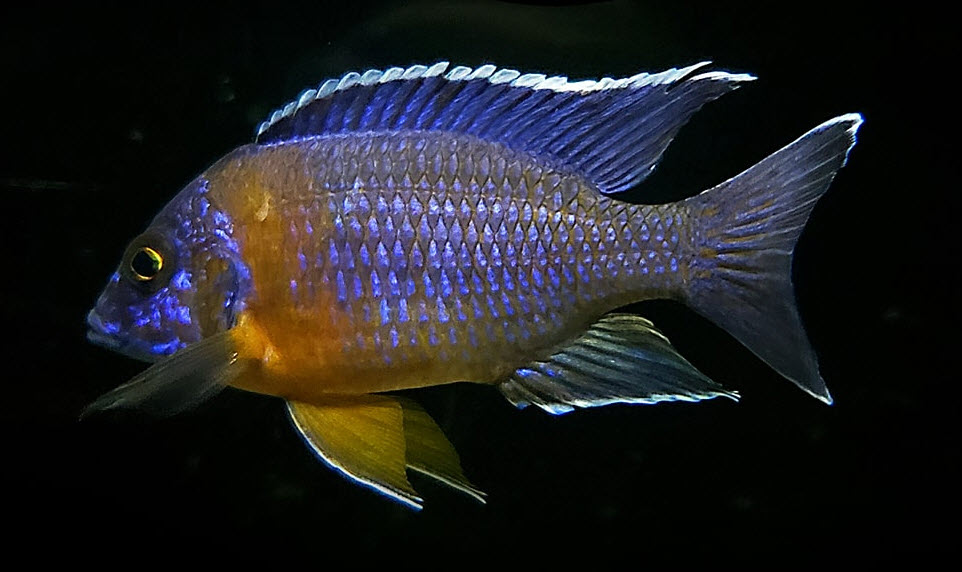
Filter Ammonia Oxidation Test Results
Ammonia was added to aquariums with various filters. The resulting ammonia levels were measured three days later, and the amount of ammonia added adjusted according to the measured ammonia level. These are the results:

The “average” number represents the number of three inch fish each filter can give crystal clear water with. The number of three inch fish that can have their ammonia oxidized is about twenty times this number. Ammonia oxidation is much easier to obtain than crystal clear water.
Note that the “One Inch of Gravel” in this test fairly well puts to rest the idea that the substrate in an aquarium acts as an ammonia oxidizer. This idea is a myth, per this test. Note that 0.5 is the ammonia that a few three inch fish would put out, so it is possible to have an aquarium with no filter in it and no ammonia. It’s just that the stocking must be very light. A gravel substrate is a very weak biofilter.
This test can be reviewed at this link:
8.1.1. Filter Test
.
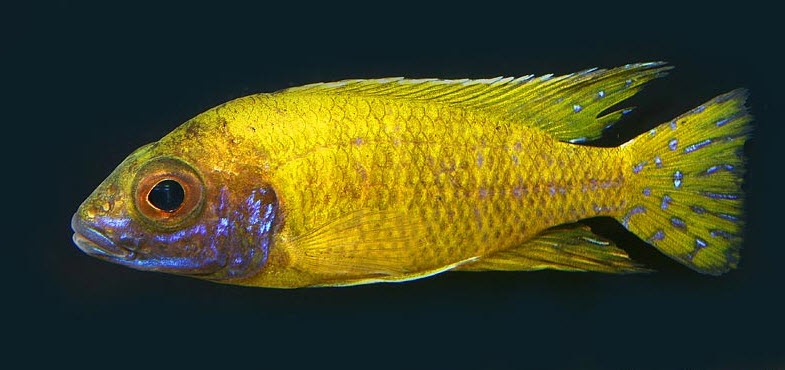
Discussion of Results
This test is easily performed by anyone who wishes to duplicate it. The average numbers would appear to be representative of the number of four-inch fish this filter can give crystal clear water with (after 90 days with no cleaning). To get the number of four-inch fish for which these filters will remove the ammonia one needs to multiply the average number of fish by twenty. Ammonia oxidation is twenty times easier than obtaining crystal clear water.
Myths About Aquarium Filters
There are many myths parroted around social media about filters. These myths include:
- The brown “gunk” inside the filter bio-media or filter foam is trapped feces and it is beneficial to the aquarium to remove it frequently and thoroughly. This is the single most damaging myth in the Hobby.
- Hang-on-back filters which use cartridges, such as Marineland Penguintm, Aqueon Quietflowtm, Tetra Whispertm and Fluval Aqua-Cleartm, should have the cartridges replaced every month to three months.
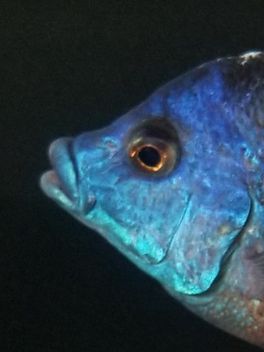
- Filters should be cleaned at least every month.
- Filters and sponges must be cleaned in aquarium water and never in chlorinated water.
- Under-gravel filters don’t work well.
- Hang-on-back filters are filters which give great biological filtration.
- Most canister filters filled with the media that comes with them (typically ceramic rings and bio-balls) are great biological filters.
- As long as the filtration is adequate to oxidize ammonia, more filtration will not help the health of the fish.
- The larger the filter the less nitrates in an aquarium and the fewer water changes required.
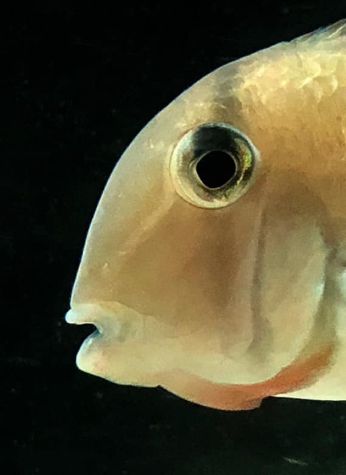
- There are bad types of filters called “nitrate factories”.
- Under-gravel filters need lots of maintenance.
- Only the flow rate in gallons per hour determines filter efficiency, not square feet of bio-media surface.
- A canister which has an actual flow rate of 600 GPH (gallons per hour) can filter roughly twice the amount of fish that a canister that has an actual flow rate of 300 GPH.
- “K1” fluidized beds take longer to cycle than standard submerged beds.
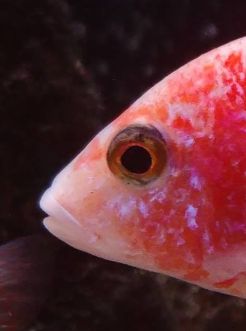
- “K1” fluidized beds are not efficient as submerged static media beds.
- Trickle filters are very efficient filters.
- Wet/dry filters are very good efficient filters.
- There are anaerobic nitrate removing reactor designs commercially available which work well in the aquarium.
.
All these myths are simply false!
.

The following sections try to explain the different choices one can make in far more depth:
8.1. Review of Types of Filters
8.2. Hang-on-back Filters
8.3. Canister Filters
8.3.1. Canisters in Depth
8.3.2. Do-it-yourself Canisters
8.3.3. FX Series Canister Filters
8.4. Sponge Filter
8.5. Under-gravel Filters
8.6. Sumps
8.6.1. Sumps in Depth
8.6.2. Static Submerged Media Sumps
8.6.3. Trickle Filters
8.6.4. Wet-dry Sumps
8.6.5 Fluidized Bed Sumps
8.6.6. Do-it-yourself Sump
8.6.7. Foam Sump
8.7. Other Types of Filters
8.7.1. Sand Filters
8.7.2. “High Performance” Filters
8.7.3. Hamburg Matten Filters
8.7.4. Diatomaceous Earth Filters
8.7.5. DIY Bottle Filters
8.7.6. Small Filters
8.7.7. Bottom of Tank Matten
8.7.8. Small DIY Filters
8.8. Sizing Filters and Media
8.9. Anaerobic Reactors
8.9.1. Biocenosis Reactor

.
Return to Home Page and Main Menu
.
Aquarium Science Website
The chapters shown below or on the right side in maroon lead to close to 400 articles on all aspects of keeping a freshwater aquarium. These articles have NO links to profit making sites and are thus unbiased in their recommendations, unlike all the for-profit sites you will find with Google. Bookmark and browse!
.

Anonymous says
I would love to hear what you think about using a air lift system on a large scale say 500 or a 1000gallon aquarium is there anything that would be different on the design at that scale
Dave says
arepus …… No, In 99% of all aquarium filters nitrogen is removed as nitrate in the form of water changes and plant harvesting. Removing it in the form of biofilm (assimilatory denitrification) is possible but difficult.
arepus says
After a few years of knowing your site and a few occasional conversations, I have begun to have doubts about some of the statements. Today I would like to question the statement “Replacing the Filter Media is a Big SCAM”. Business and truth are different words, no one argues, but what if regular removal of filter media is the easiest and most powerful way to remove nitrogen incorporated in biofilm proteins in the media?
Annemarie Cox says
Hi, I’ve really enjoyed making my way through your site. I’ve been in the hobby for 30 years. Lots of trial and error!
Anyway, long story short, my Dad left me a gift in his will and I’m having my dream tank built. Early retirement gift to myself a 84lx24deep and 16 high. I’ll be consolidating my 75 and 55 planted tanks into this beauty,
So I started looking at what I know, and what I don’t and wanted to be sure about. Found your site and love it!
I started with UGF, in college in 1980. That 20 G L survived for many years of neglect. Some scrappy low light plants and fish. I was clueless but that filter worked!
I was getting worried reading all the “can’t have plants with UGF@ but you and a few others reassured me. I’ll transplant my swords in pots and see how all the other plants do. I’ll be moving a lot of my current substraight into the new tank and capping it with STS that has been “charged”. The UGF will have a good kick start, while I’ll run my current HOB s and gradually shift the workload to the UGF.
I looked into the research you cited for ammonia and cycling. It makes sense…all those fish in cycles that worked for folks with “deadly” levels…it WASNT THE PRIME!! LOL. Found several other folks that posted their own research showing no effect in ammonia….
Anyway thanks for all the great info and research citations. I like fact checking, a skill more folks in our country could use in todays world!
Dave says
In reply to Anon …. wood is just fine but large rocks or lots of rocks can present a problem with breaking the thin plastic plates. My old plates have a much stronger material in them than the new ones.
Anon says
How careful do I have to be putting hard scape like rocks and wood when using an under gravel filter?
Dave says
In reply to anonymous ….. There is no good way to predict the behavior of any species of plant in the aquarium. There are just too many variables. So just try it and see what happens.
Anonymous says
In continuing my previous question, what if I did a bucephalandra only tank? They grow in the wild in very turbulent streams. If the water there is so turbulent, wouldn’t there not be much co2 so aeration in the aquarium would fine?
Dave says
IN reply to Anonymous …. That would be too much flow for a planted tank. And I have no information or experience with Bucephanlandra and undergravel filters.
Anonymous says
Would two 135 GPH powerheads be too much flow for a planted twenty gallon?(The UGFs for twenty gallons have 2 uplift tubes.) Also, does Bucephanlandra do well with UGFs?
Thanks
ben z says
@Dave
Your reply to Anonymous somewhat contradicts what you wrote about the reason the FX series are your favourite filters. From your article on FX canisters:
“As the water flows up the first time it flows through the foam from the outside of the canister to the inside of the foam ring. This means the maximum surface area of foam being exposed to the flow. This gives great biological filtration.”
Assuming that an under gravel filter with such a rectangular block can work in the first place, and that the majority of the water flow is from bottom to up, then by the above logic, there should be a notable difference between such a UGF and a sponge filter. Not least because such a UGF would probably be placed in the corner of the tank, presumably with two or even three sides flush with the tank walls – ergo much reduced water flow through those sides.
Another problem with the idea is whether the water flow will actually go from top to bottom. There’s good reason to believe that it wouldn’t. Imagine a 4 ft by 2 ft by 2 foot tank, and we have 1 ft by 1 ft UGF plate in one back corner of the tank with a cubic foot of foam on top. Since the pressure loss is such that water is drawn to the slits of the UGF, and water takes the path of least resistance, what’s most likely to happen is that most if not all of the flow would be through the bottom few inches of the foam faces exposed to the bulk water. There’s no reason why water would flow from the top through 12 inches of foam to the plates if it can take an easier path through the bottom part of the foam.
One can argue that the other surfaces would still have gunk and do biofiltration, but that would be like comparing Poret’s MMBR foam cubes to K1.
Do correct me if there are any problems with my analysis.
Incidentally, I do believe that flow rates have greater significance than you concluded in your articles. Your tests covered ammonia oxidation, and I agree with your conclusions. But when it comes to particulate/dissolved organics, flow rates should in theory take on greater significance. As you wrote, clear water requires enough surface area to provide enough brown gunk to outcompete the free floating bacteria for nutrients, and that requires enough “biogunk” in the filter to do it in one pass. By that logic, flow rates take on greater significance, since the more times those nutrients pass through, the greater the window for the biogunk to outcompete the free floaters.
The other effect of flow rate is indirect – greater flow rates imply greater suction by the pump, and hence thinner and more efficient biofilms, and in turn much less clogging down the road. This matters a huge deal at very high stocking levels.
Dave says
In reply to anonymous ….. If you are talking about a Matten undergravel filter the filter capacity is VERY ROUGHLY the same as the same volume of foam in a sponge filter. But one has to temper that with the caveat that this is far from an exact science so results will vary considerably.
Anonymous says
This is probably self explanatory and obvious but let’s say for example I have an undergravel filter with a static rectangular tower of 20 ppi filter foam. Will that prism of foam act as biofilte with same capacity as if it was sponge filter due to the water flow being directed from thr surface to the bottom. Or is the tower filter capacity reduced because the flow is only directed from one side.